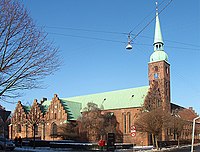Church of Our Lady (Aarhus)
| Church of Our Lady | |
|---|---|
 |
|
| 56°09′29″N 10°12′18″E / 56.158°N 10.205°ECoordinates: 56°09′29″N 10°12′18″E / 56.158°N 10.205°E | |
| Location |
Vestergade 21 8000 Aarhus |
| Country | Denmark |
| Denomination | Church of Denmark |
| Architecture | |
| Status | Church |
| Completed | 1060 |
| Specifications | |
| Materials | Brick |
| Administration | |
| Archdiocese | Diocese of Aarhus |
The Church of Our Lady (Danish: Vor Frue Kirke) is one of the largest churches of Århus, Denmark. It is situated in the centre of the city not far from Aarhus Cathedral (Århus Domkirke). The church's crypt contains a stone church dating to 1060 AD.
The church was originally known as St. Nicholas' Church but was expanded by the construction of a Dominican priory in 1240, the Vor Frue Kloster (Our Lady's Priory), of which the present church formed the southern wing. After the Reformation in Denmark, the name was changed to the Church of Our Lady and King Christian III decreed that the surrounding buildings, formerly a priory of the Dominicans, should function as a hospital for the sick and poor. The church was subsequently granted congregational privileges which officially made it a centre for clerical activities in its area.
Between 1250 and 1500 the church was heavily expanded by the addition of, among other things, the large tower. In the 1950s a crypt-church was rediscovered beneath the church during renovations. The crypt church dates to approximately 1060 AD. The church has since been renovated again in 2000.
The crypt church is the oldest extant stone church in Scandinavia. Built in 1060 after the old wooden church had been burned in an assault on the town, the church is situated beneath the main building of the Church of Our Lady. After its discovery in the 1950s, it was restored and reopened on 10 November 1957 and is now used for mass once a week.
During the restoration by the Danish National Museum, two graves were found - one of a child and one of an adult - and 23 coins from the 14th century. Five of these coins were from Lübeck and the rest from Hamburg.
The crypt church was initially built as an attempt to weaken Adalbert, archbishop of Hamburg-Bremen, who had considerable influence on Danish clerical matters, as the head of the Danish church. Svend Estridsen (1047–1074) divided Denmark into 8 bishoprics, and in 1060, Christian became the first bishop of Aarhus. The crypt church was built the same year.
...
Wikipedia
